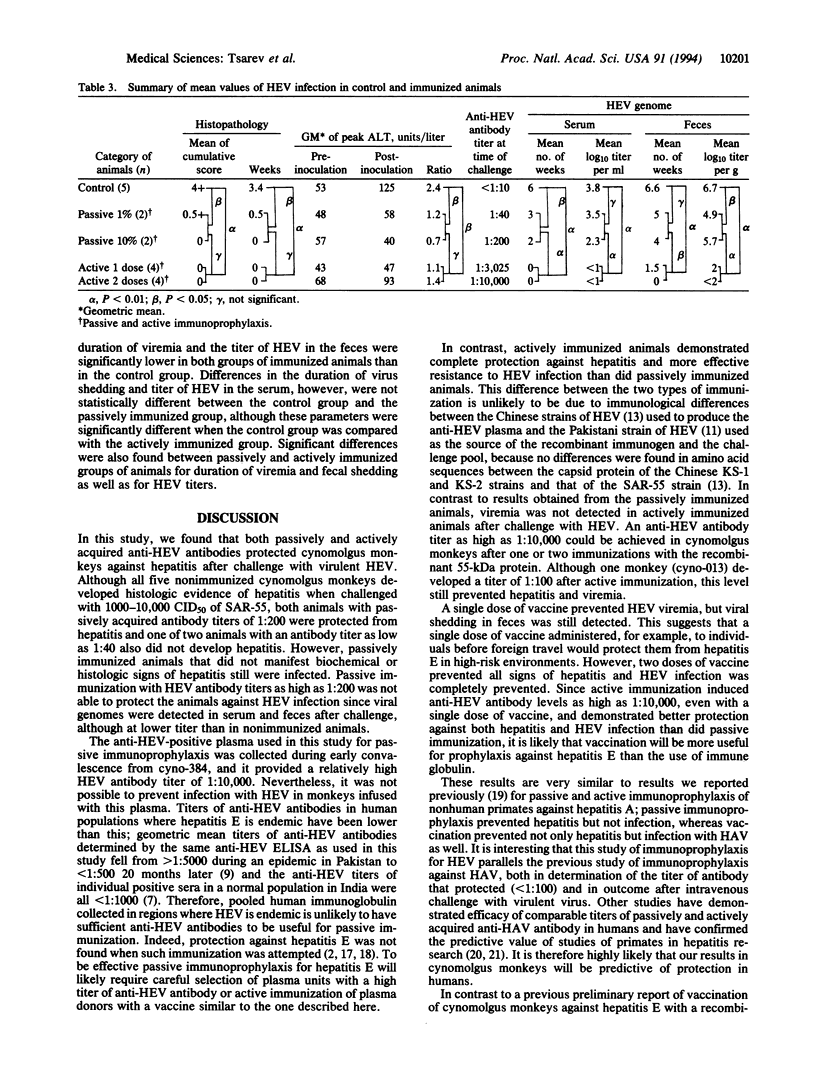Abstract
Virtually full protection against hepatitis E and partial or complete protection against infection with hepatitis E virus (HEV) were achieved in passively or actively immunized cynomolgus monkeys. Hepatitis, viremia, and shedding of the virus in feces were detected in all nonimmunized animals that were challenged with HEV. HEV titers detected by reverse transcriptase PCR were higher in feces than in serum of nonimmunized animals. Anti-HEV antibody titers at the time of challenge ranged between 1:40 and 1:200 in animals passively immunized with convalescent plasma from a cynomolgus monkey previously infected with HEV and between 1:100 and 1:10,000 in animals actively immunized with a recombinant 55-kDa open reading frame 2 protein. The estimated 50% protective titer of passively acquired anti-HEV antibodies was 1:40. Although only one of four passively immunized animals showed histopathologic evidence of hepatitis, all four were infected after challenge; however, the titers of HEV in serum and feces were lower in the passively immunized animals than in the nonimmunized group. The actively immunized animals developed neither hepatitis nor viremia when challenged with HEV and virus was either not detected or was present in low titer in feces. The protective response was a function of the ELISA anti-HEV antibody titer at the time of challenge and the immunization schedule.
Full text
PDF




Selected References
These references are in PubMed. This may not be the complete list of references from this article.
- Balayan M. S., Andjaparidze A. G., Savinskaya S. S., Ketiladze E. S., Braginsky D. M., Savinov A. P., Poleschuk V. F. Evidence for a virus in non-A, non-B hepatitis transmitted via the fecal-oral route. Intervirology. 1983;20(1):23–31. doi: 10.1159/000149370. [DOI] [PubMed] [Google Scholar]
- Bryan J. P., Tsarev S. A., Iqbal M., Ticehurst J., Emerson S., Ahmed A., Duncan J., Rafiqui A. R., Malik I. A., Purcell R. H. Epidemic hepatitis E in Pakistan: patterns of serologic response and evidence that antibody to hepatitis E virus protects against disease. J Infect Dis. 1994 Sep;170(3):517–521. doi: 10.1093/infdis/170.3.517. [DOI] [PubMed] [Google Scholar]
- Joshi Y. K., Babu S., Sarin S., Tandon B. N., Gandhi B. M., Chaturvedi V. C. Immunoprophylaxis of epidemic non-A non-B hepatitis. Indian J Med Res. 1985 Jan;81:18–19. [PubMed] [Google Scholar]
- Khuroo M. S., Dar M. Y. Hepatitis E: evidence for person-to-person transmission and inability of low dose immune serum globulin from an Indian source to prevent it. Indian J Gastroenterol. 1992 Jul;11(3):113–116. [PubMed] [Google Scholar]
- Khuroo M. S. Study of an epidemic of non-A, non-B hepatitis. Possibility of another human hepatitis virus distinct from post-transfusion non-A, non-B type. Am J Med. 1980 Jun;68(6):818–824. doi: 10.1016/0002-9343(80)90200-4. [DOI] [PubMed] [Google Scholar]
- Khuroo M. S., Teli M. R., Skidmore S., Sofi M. A., Khuroo M. I. Incidence and severity of viral hepatitis in pregnancy. Am J Med. 1981 Feb;70(2):252–255. doi: 10.1016/0002-9343(81)90758-0. [DOI] [PubMed] [Google Scholar]
- Purcell R. H., D'Hondt E., Bradbury R., Emerson S. U., Govindarajan S., Binn L. Inactivated hepatitis A vaccine: active and passive immunoprophylaxis in chimpanzees. Vaccine. 1992;10 (Suppl 1):S148–S151. doi: 10.1016/0264-410x(92)90572-2. [DOI] [PubMed] [Google Scholar]
- Purdy M. A., McCaustland K. A., Krawczynski K., Spelbring J., Reyes G. R., Bradley D. W. Preliminary evidence that a trpE-HEV fusion protein protects cynomolgus macaques against challenge with wild-type hepatitis E virus (HEV). J Med Virol. 1993 Sep;41(1):90–94. doi: 10.1002/jmv.1890410118. [DOI] [PubMed] [Google Scholar]
- Stapleton J. T., Jansen R., Lemon S. M. Neutralizing antibody to hepatitis A virus in immune serum globulin and in the sera of human recipients of immune serum globulin. Gastroenterology. 1985 Sep;89(3):637–642. doi: 10.1016/0016-5085(85)90462-7. [DOI] [PubMed] [Google Scholar]
- Tsarev S. A., Emerson S. U., Tsareva T. S., Yarbough P. O., Lewis M., Govindarajan S., Reyes G. R., Shapiro M., Purcell R. H. Variation in course of hepatitis E in experimentally infected cynomolgus monkeys. J Infect Dis. 1993 Jun;167(6):1302–1306. doi: 10.1093/infdis/167.6.1302. [DOI] [PubMed] [Google Scholar]
- Tsarev S. A., Tsareva T. S., Emerson S. U., Kapikian A. Z., Ticehurst J., London W., Purcell R. H. ELISA for antibody to hepatitis E virus (HEV) based on complete open-reading frame-2 protein expressed in insect cells: identification of HEV infection in primates. J Infect Dis. 1993 Aug;168(2):369–378. doi: 10.1093/infdis/168.2.369. [DOI] [PubMed] [Google Scholar]
- Tsarev S. A., Tsareva T. S., Emerson S. U., Yarbough P. O., Legters L. J., Moskal T., Purcell R. H. Infectivity titration of a prototype strain of hepatitis E virus in cynomolgus monkeys. J Med Virol. 1994 Jun;43(2):135–142. doi: 10.1002/jmv.1890430207. [DOI] [PubMed] [Google Scholar]
- Velázquez O., Stetler H. C., Avila C., Ornelas G., Alvarez C., Hadler S. C., Bradley D. W., Sepúlveda J. Epidemic transmission of enterically transmitted non-A, non-B hepatitis in Mexico, 1986-1987. JAMA. 1990 Jun 27;263(24):3281–3285. [PubMed] [Google Scholar]
- Wong D. C., Purcell R. H., Sreenivasan M. A., Prasad S. R., Pavri K. M. Epidemic and endemic hepatitis in India: evidence for a non-A, non-B hepatitis virus aetiology. Lancet. 1980 Oct 25;2(8200):876–879. doi: 10.1016/s0140-6736(80)92045-0. [DOI] [PubMed] [Google Scholar]
- Yin S., Tsarev S. A., Purcell R. H., Emerson S. U. Partial sequence comparison of eight new Chinese strains of hepatitis E virus suggests the genome sequence is relatively stable. J Med Virol. 1993 Nov;41(3):230–241. doi: 10.1002/jmv.1890410311. [DOI] [PubMed] [Google Scholar]


